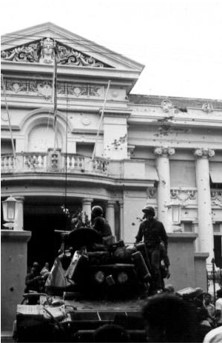President Diem is Overthrown and Assassinated
November 2, 1963

Generals in the South Vietnamese Army depose President Ngo Dinh Diem and assassinate Diem and his brother Ngo Dinh Nhu. While U.S. officials have disagreed over U.S. support of a potential coup, in pressuring Diem and cutting U.S. aid, they realize that they are encouraging the South Vietnamese military leaders to move forward. All the same, U.S. Ambassador Henry Cabot Lodge, Jr. and other American officials have little direct impact on the plan or execution of the coup.
After President Ngo Dinh Diem’s overthrow, South Vietnam enters a period of even greater instability. The Diem regime’s elimination does not offer a remedy for the country’s political or institutional problems, and the bureaucratic structure in South Vietnam continues to deteriorate. A series of additional coups ensues over the next few years and power fluctuates between separate anti-Diem factions. Most of these new governments only last for months.1
A number of historical analyses of Ngo Dinh Diem portrayed him as an American puppet whose authoritarian tendencies were ill-suited for democratic rule. These scholars argue that Diem governed according to a political style called Personalism, which was an attempt to blend Buddhist cultural attitudes and nationalism. However, Diem largely failed to win the support of most South Vietnamese. Diem, himself a Catholic, also aroused ire by privileging minority Catholics over majority Buddhists for positions in the South Vietnamese bureaucracy and military. These scholars argue that the United States slowly grew frustrated with Diem’s lack of success in defeating the Communist insurgency in South Vietnam, and the United States at the least passively enabled the coup that overthrew him in 1963. Following Diem’s ouster and assassination, competing interests and disunity among the South Vietnamese military general officers, civilian businessmen, religious leaders, criminal syndicates, and peasants ensured that any political regime in Saigon would struggle for stability in the face of North Vietnamese and Viet Cong pressure.
Revisionist historians, who often characterize the Vietnam War as a noble endeavor poorly managed, tend to fault the Kennedy Administration for ousting the only politician capable of holding South Vietnam together. These historians argue that while Diem was flawed, he was a talented and capable politician, and his authoritarian tendencies were needed to control a newly independent nation at war with a Communist aggressor backed by the Soviet Union and China. The United States’ negative appraisal of Diem, these scholars argue, came from American journalists, who had little understanding of South Vietnamese politics. This false impression of government in Saigon, revisionist historians contend, led policy makers in Washington to allow the coup against Diem to proceed. Without Diem in power, the United States had to spend the next decade propping up a government in Saigon made up inexperienced generals. Thus, revisionist scholars argue, victory in South Vietnam was forsaken first by the Kennedy Administration’s poor decision to let Diem fall in 1963.
Recent scholarship, largely based on Vietnamese-language sources, emphasizes that Diem not only feared communism, but American-backed liberal democracy as well. This new school of scholars maintains that Diem, especially at the beginning of his tenure, was not beholden to the United States. Neither puppet nor fool, Diem wished to modernize South Vietnam on its own terms, enabling the peasants to prosper while respecting Vietnam’s diverse group of elites. The methods Diem used to bring about this vision often put him at odds with Washington policy makers’ ideas on international development because he sought to limit American influence in South Vietnam. By 1963, the Americans had grown weary of Diem’s modernization projects, but the coup that led to his downfall was very much a Vietnamese affair. Some of these scholars believe that Diem intended to bait his political opponents into attempting a coup against him in 1963, and then he planned to oust his rivals in a countercoup and drive the Americans from South Vietnam by brokering a deal with the Communists. Ultimately, this scheme failed when key supporters betrayed him. This historical interpretation characterizes Diem as being much more like Ho Chi Minh than the generals who succeeded him: Diem remembered Vietnam’s colonial legacy under the French, and he aimed to prevent the Americans from establishing a similar hegemony over his country. After Diem’s demise, these historians recount, political chaos reigned in South Vietnam, the Americans further intervened to protect the political regime in Saigon, and Hanoi took advantage of the situation by presenting their political movement as the only one capable of delivering Vietnamese independence.
Catton, Philip E. Diem’s Final Failure: Prelude to America’s Final War in Vietnam. Lawrence: University Press of Kansas, 2002.
FitzGerald, Francis. Fire in the Lake: The Vietnamese and the Americans in Vietnam. Boston: Vintage Books, 1972.
Sheehan, Neil. A Bright Shining Lie: John Paul Vann and America in Vietnam. New York: Vintage Books, 1988.
Moyar, Mark. Triumph Forsaken: The Vietnam War, 1954-1965. New York: Cambridge University Press, 2006.
Hess, Gary R. Vietnam: Explaining America’s Lost War. Malden, MA: Blackwell Publishing, 2009.
Dommen, Arthur J. The Indochinese Experience of the French and Americans: Nationalism and Communism in Cambodia, Laos, and Vietnam. Bloomington: Indiana University Press, 2001.
Miller, Edward Garvey. Misalliance: Ngo Dinh Diem, the United States, and the Fate of South Vietnam. Cambridge: Harvard University Press, 2013